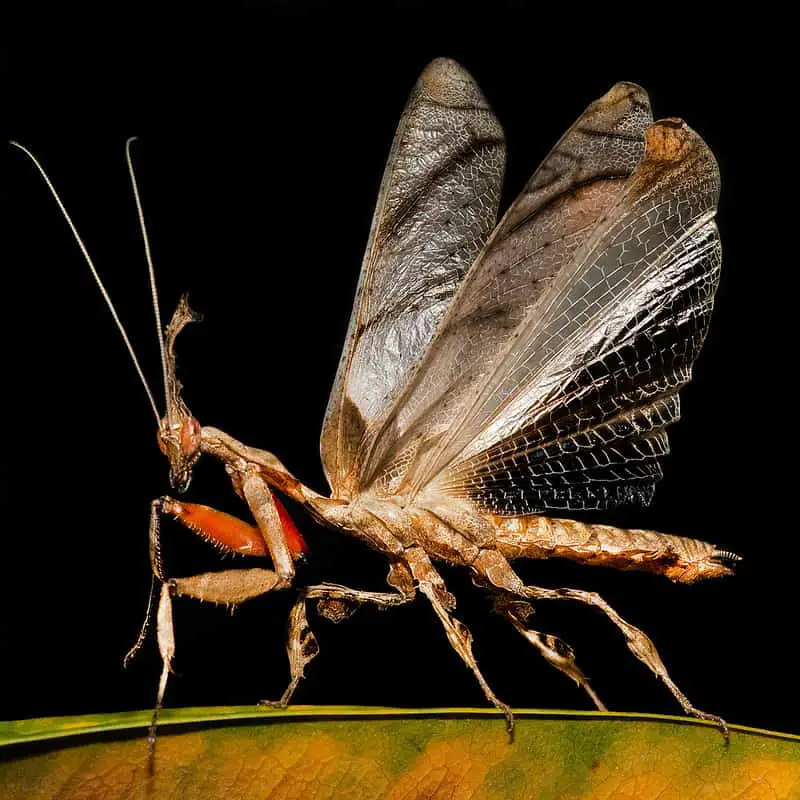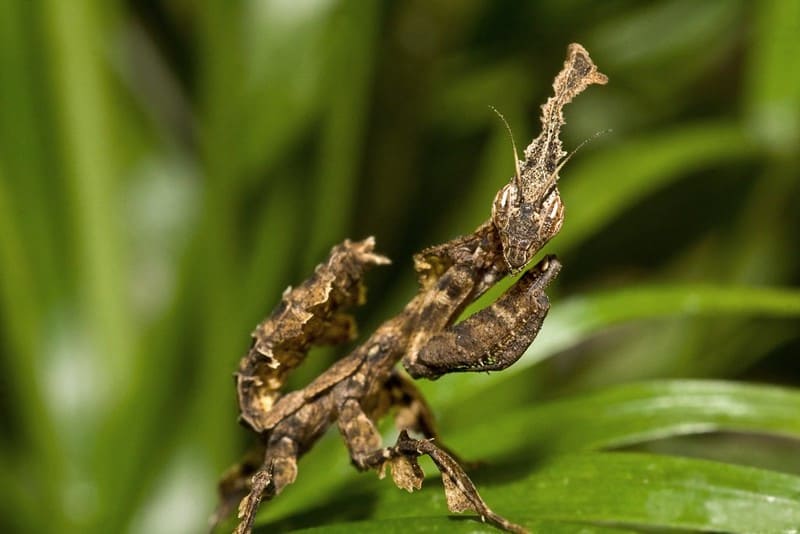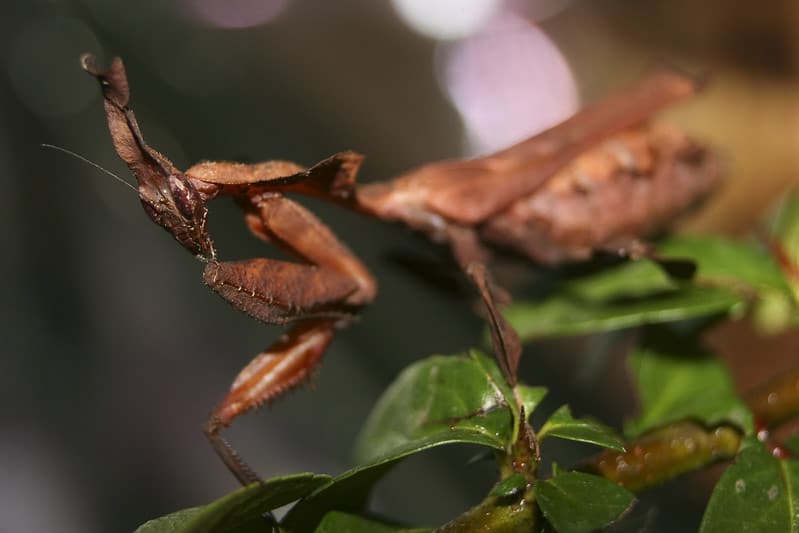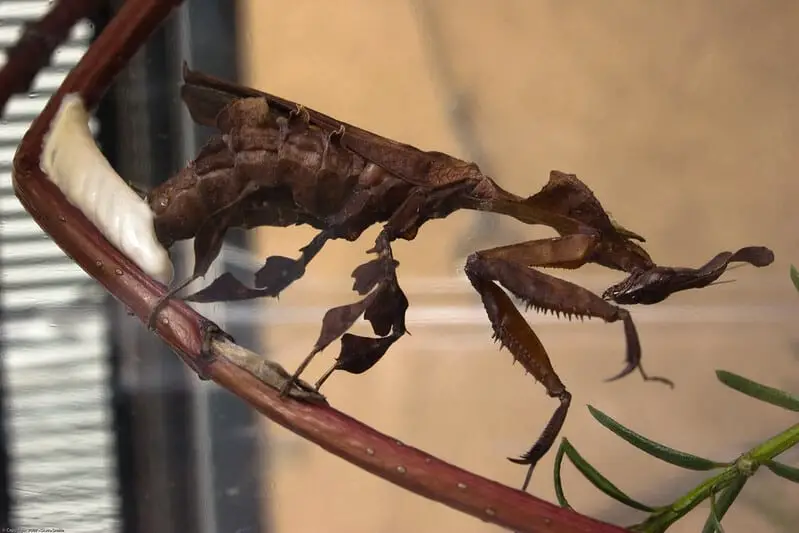The Ghost Mantis (Phyllocrania Paradoxa) is an enigmatic mantis species native to the African continent and Madagascar.
This species is quite popular in the insect-keeping hobby. It usually displays dark brown colors from greenish to light brown depending on the environment and humidity.
It’s known for being one of the few species that can sustain communal life and for feeding naturally from most common pests, making it ideal for keeping inside greenhouses.
If you are planning to expand your mantids collection or are looking to get into the hobby, here is everything you need to know about the beautiful Ghost Mantis!

Ghost Mantis Care Sheet
| Name of species | Phyllocrania paradoxa |
| Family | Hymenopodidae |
| Common name | Ghost Mantis |
| Category | Mantis |
| Type | Macropterous |
| Native location | Madagascar, Africa |
| Temperature | 68 °F to 86 °F |
| Humidity | 60% to 90% |
| Size | 1.8 to 2.0 inches (4.5 to 5 cm) |
| Diet | Small flying insects |
| Lifespan | 8 months |
| Experience level | Beginner |
Ghost Mantis Overview

The Phyllocrania paradoxa, commonly known as the Ghost Mantis, is found in an extensive area of the African continent and its surrounding islands such as Angola, Cameroon, Ghana, Zimbabwe, and many others. However, it’s most frequently found in Madagascar.
It’s considered Macropterous since it has long wings used for flying; it also feeds mostly from small flying insects by stalking them from a branch, so the wings aren’t used for hunting, but more for getting around.
It’s also considered a leaf mantis since its appearance resembles a leaf. The Ghost Mantis can live comfortably in captivity, as long as you provide them with the right environment.
Appearance & Variations
The Ghost Mantis displays dark colors that match the gloomy environment; typically, dark brown to almost black colors can fluctuate depending on the surroundings and humidity, but the colors can sometimes turn greenish-grey.

Its colors are adapted at an early age while molting, so it’s easy to lead its color development by changing its tank set up to achieve the desired tones.
Its razor-like fore legs are ideal for grabbing and retaining prey, and it has leaf-like adornments on all other limbs. It has a lengthened head with a flat and asymmetric surface that is capable of rotating up to 180º, ideal for turning into a more leaf-like form for camouflage.
The Ghost Mantis also has long wings that cover the abdomen with “creases” over the wings that are shadings of pigment.
The ghost mantis exhibits sexual dimorphism. As they mature, females get bulkier and males thinner, with longer and slender antennas and wings that go past de abdomen.
They are good flyers, though females tend not to fly very far since they are heavier, their antennea are more compact, and their wings are shorter.
In addition, females have a six-segment abdomen, while males have eight segments. However, while females are slightly larger, the difference in size is usually not big enough to be a good criterion for telling males and females apart.
Price
The Ghost Mantis’ market price goes from $24 to $50, depending on gender and maturity state. Nymphs of L2 to L3 go for as little as $24, while L4 to L5 nymphs are between $28 and $30 each.
Adult males go for around $35 to $40, while adult females get around $45 to $50 in some cases.
It’s pretty common to buy them in bulk since they’re fit for communal life; deals are usually for four to ten specimens at the same time on some websites with a price of $20 each.
Behavior and Temperament
Though it has an eccentric name, the Ghost Mantis exhibits a calm demeanor, even with other members of the same species.
They keep their distance and rarely recur to feeding on one another, which is a rarity among mantids, making them suitable for communal life.
They camouflage themselves as dried-up leafs turning over their own body to be more accurate in evading predators’ gaze while waiting for prey.
They usually don’t pursue their food but instead, wait for the right moment to ambush and catch it. If threatened, they can enter an almost dead pose to divert attention, but males mostly tend to fly away at the first chance they get.
Considering their mild temperament and behavior, the GM is ideal for all newcomers who are trying to get their first mantis.
Caring for a Ghost Mantis

Temperature and Humidity
The GM can live comfortably with temperatures around 68 °F to 86 °F, but 79 °F is the ideal measure. It needs high humidity to resemble its natural habitat, so a humidity level between 60% and 90% is best for them. To achieve this, you must spray the enclosure frequently and ensure adequate ventilation.
Substrate
The GM uses around one to two inches of substrate in most cases to keep them happy. High humidity is of utmost importance for their survival, so topsoil and peat moss are the standard choices to keep in the substrate mix.
Organic soil is another good option if you’re up to keeping a bioactive enclosure because they feel most at home with plenty of vegetation.
Tank
The GM’s enclosure should have at least three times the specimen’s length in height and twice its length width.
However, most hobbyists will get larger tanks of around five to ten gallons to house several specimens in the same place.
As long as your mantids are well-fed, they won’t turn into cannibalism. Also, ensure the tank has adequate ventilation, or else you risk mold formation and diseases.
For decoration, plenty of dried-up leaves and branches are desirable to give them a place to climb and disappear.
If you’re looking to create a bioactive enclosure, a couple of plants will help keep humidity levels and make them feel comfortable; be aware though that you’ll likely have trouble finding your Ghost Mantises due to their excellent camouflage.
Watering
The GM needs high humidity levels to survive, so spraying the enclosure about five times per week is advisable.
Depending on the temperature, it can be done even twice a day. Distilled water has been the best choice for the job, but any chemical-free water is suitable.
This species normally gets its hydration while feeding on its prey, but sometimes it uses drops from the enclosure. As such, a water bowl is not really necessary as long as you keep the humidity up. Of course, if you want to be on the safe side you can equip their enclosure with a small bottle cap filled with water.
Diet & Feeding
The Ghost Mantis diet is fairly easy, using flies as the focus of their diet. L1 nymphs can be well fed with small fruit flies. L2 and L3 nymphs can start with small fruit flies and then step up to big ones. L4 and L5 nymphs love green bottle flies, while L6 to L8 vary between green bottle flies and blue bottle flies.
Adult Ghost Mantises can eat blue bottle flies for the rest of their lives without complaint, even though they can eat other insects like moths and small grasshoppers as well.
As long as you feed them well, they’re going to stay healthy. The GM’s approach to hunting is peaceful, seldom pursuing its prey actively.
The Ghost Mantis is quite weak compared to other mantids species. Therefore, it’s important that you keep their prey relatively small. If the prey is small enough, they won’t have any issues feeding themselves.
You can use the abdomen’s plumpness and flatness to discern if they require any nutritional rectifications, so you’ll know if they’re being overfed or underfed and be able to adapt their diet accordingly.
Molting
Throughout its life, the Ghost Mantis will molt several times. You’ll know that they’re about to molt because they will hang motionless upside down. When you see this, it’s important that you do not disturb them as molting is a stressful time for them.
Furthermore, it’s important to note that right before a molt the insect will refuse to eat. This is normal behavior and nothing to worry about. In addition, you should refrain from feeding your mantis for about 24 hours after a molt to give their exoskeleton time to harden. Refrain from handling them for at least 48 hours, since they’re quite fragile right after a molt.
Communal Living
The Ghost Mantis is one of the few mantids that is capable of communal living. What this means is that you can have more than one of these insects in a single enclosure without them resorting to cannibalism.
If you plan on housing them communally, here’s a video with good information about setting things up.
When housing them communally it is very important that you always provide them with enough food and a large enough enclosure with space for all of them. If they do not have enough food and space it’s very likely that they will resort to cannibalism.
Furthermore, it’s important that the specimens you house together are at the same instar. What this means is that you should never house L1 nymphs with L2, L3, or higher instar specimens. The size difference will be very large, which makes cannibalism more likely.
In addition, males are typically more docile than females, so if you plan on communal housing it’s best to use males for this purpose.
However, even though cannibalism is unlikely in this species, it’s still something you need to take into account. The risk of this happening always exists, even with the docile Ghost Mantis.
Health & Lifespan
The Ghost Mantis typically lives for about 8 months in captivity. To keep them strong and healthy it’s important that you provide them with good food and a proper enclosure. As long as you follow the guidelines provided above, your mantis should have everything it needs to thrive and live a happy life.
To prevent illness, it’s also important that you feed them only captive-bred insects. Wild-caught insects can have parasites that can transfer to your mantis, which is obviously something we want to avoid.
In addition, to prevent the growth of mold and bacteria it’s important that their enclosure is well ventilated and that you remove uneaten food in a timely matter.
Lastly, be careful when handling them. They’re fragile insects!
Fun Facts about the Ghost Mantis
- These species are weaker compared to other mantids, so they don’t fare well against other insects over twice their size.
- The Ghost Mantis changes colors with every molting having several opportunities to adapt to their current environment at different stages of the year. A popular trend with keepers is changing decoration so they can achieve several tones between stages in the same enclosure.
- It exhibits an asymmetric head that can rotate 180° and leaf-like protrusions; it revolves its own body to mimic a dried-up leaf almost perfectly.
- This is one of the few mantis species that will rarely practice cannibalism. This rare miracle makes it suitable for communal life as long as all specimens are well fed and have enough space in the enclosure
Final words: Is the Ghost Mantis right for you?
The Ghost Mantis is an elegant species, extremely calm, beautiful, and fit for beginners. Having a group of these mantids in the same habitat offers an incredible view; you won’t ever get bored while keeping them with you.
While these insects are very suitable for beginners, they have a lot to offer to more experienced keepers as well. Not only do they have very interesting behavior, but they’re also extremely beautiful to look at.
Nevertheless, if after reading about them you decide that this species is not for you, you might be interested in checking out the Carolina or Chinese mantis instead!
- How Long Do American Eskimo Dogs Live? Important Factors and Care Tips - September 29, 2023
- Do American Bulldogs Need Grooming? Essential Tips and Care Guidelines - September 29, 2023
- Do Bengal Cats Enjoy Playing? Essential Tips for Keeping Them Active - September 29, 2023